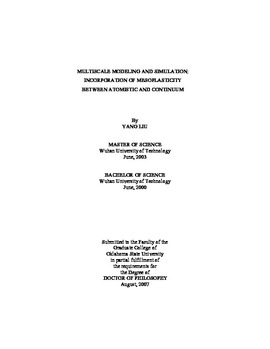| dc.contributor.advisor | Komanduri, Ranga | |
| dc.contributor.author | Liu, Yang | |
| dc.date.accessioned | 2013-12-10T18:05:19Z | |
| dc.date.available | 2013-12-10T18:05:19Z | |
| dc.date.issued | 2007-08 | |
| dc.identifier.uri | https://hdl.handle.net/11244/7805 | |
| dc.description.abstract | Scope and Method of Study: In the framework of multiscale modeling, two modeling techniques at the meso/micro scale, namely, mesoplasticity and discrete dislocation are employed to study the mechanical behavior of single crystal materials under nanoindentation. A combined finite element method (FEM)/nanoindentation approach has been developed to determine the material behavior of single-crystal copper incorporating the mesoplastic constitutive model. Nanoindentation on a single-crystal copper was modeled using mesoplasticity. Numerical and experimental investigations of nanoindentation on single-crystal copper in three crystallographic orientations, i. e., (100), (011) and (111) using a spherical indenter (3.4 um radius) and a Berkovich indenter were reported. Discrete dislocations are coupled with GIMP using the principle of superposition (van der Giessen and Needleman, 1995). Simulations of indentation were performed on the (111) plane of copper using a wedge indenter. The effects of temperature on the indentation loaddepth curves and nucleation of dislocations were investigated. | |
| dc.description.abstract | Findings and Conclusions: Nanoindentation on a single-crystal copper was modeled using mesoplasticity with a user subroutine in ABAQUS/Explicit software. For a spherical nanoindentation, distribution of the out-of-plane displacements at three crystallographic orientations, namely, (100), (011), and (111) show pile-ups with a topographical pattern of four-fold, two-fold, and three-fold symmetry, respectively in both experiments and simulations. No sink-in was observed due to the work hardened condition of the specimens. Furthermore, the comparisons between the nanoindentation and simulation on load-displacement relations and the pile-up profiles were found to be reasonably good, lending further credibility on the capability of the current model. It is concluded that the numerical model with the parameters determined is capable of predicting the single-crystal copper behavior of three orientations under nanoindentation. A multiscale simulation algorithm that couples MD, DD, and GIMP was developed and used to simulate the indentation on Cu (111) plane with a wedge indenter. Dislocation nucleation and subsequent propagation of dislocations are observed for the indentation simulation. | |
| dc.format | application/pdf | |
| dc.language | en_US | |
| dc.rights | Copyright is held by the author who has granted the Oklahoma State University Library the non-exclusive right to share this material in its institutional repository. Contact Digital Library Services at lib-dls@okstate.edu or 405-744-9161 for the permission policy on the use, reproduction or distribution of this material. | |
| dc.title | Multiscale modeling and simulation: Incorporation of mesoplasticity between atomistic and continuum | |
| dc.contributor.committeeMember | Lu, Hongbing | |
| dc.contributor.committeeMember | Coker, Demir | |
| dc.contributor.committeeMember | Raff, Lionel | |
| osu.filename | Liu_okstate_0664D_2485.pdf | |
| osu.accesstype | Open Access | |
| dc.type.genre | Dissertation | |
| dc.type.material | Text | |
| dc.subject.keywords | multiscale modeling | |
| dc.subject.keywords | finite element method (fem) | |
| dc.subject.keywords | mesoplasticity | |
| dc.subject.keywords | single crystal copper | |
| dc.subject.keywords | nanoindentation | |
| dc.subject.keywords | discret | |
| thesis.degree.discipline | Mechanical Engineering | |
| thesis.degree.grantor | Oklahoma State University | |
